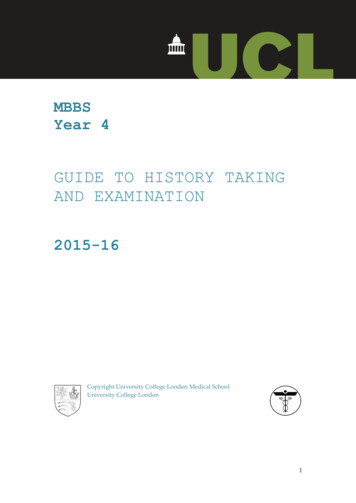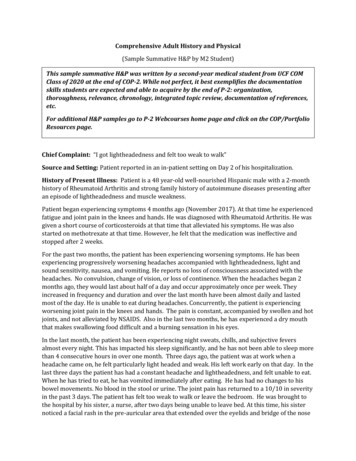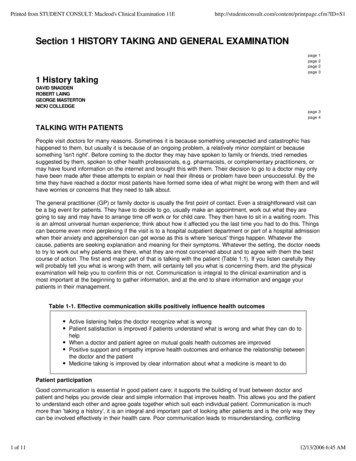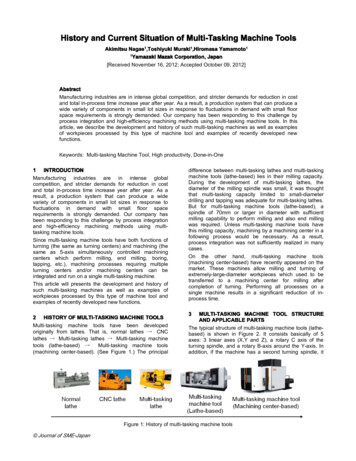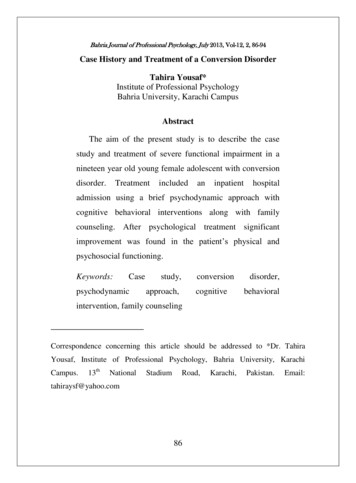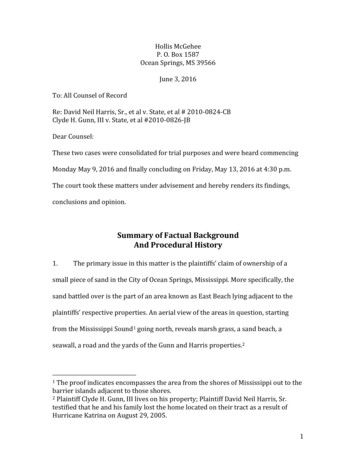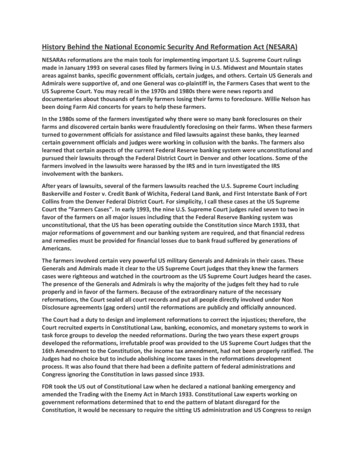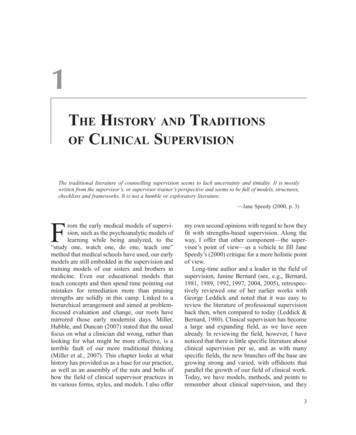
Transcription
1The History and Traditionsof Clinical SupervisionThe traditional literature of counselling supervision seems to lack uncertainty and timidity. It is mostlywritten from the supervisor’s, or supervisor trainer’s perspective and seems to be full of models, structures,checklists and frameworks. It is not a humble or exploratory literature.—Jane Speedy (2000, p. 3)From the early medical models of supervision, such as the psychoanalytic models oflearning while being analyzed, to the“study one, watch one, do one, teach one”method that medical schools have used, our earlymodels are still embedded in the supervision andtraining models of our sisters and brothers inmedicine. Even our educational models thatteach concepts and then spend time pointing outmistakes for remediation more than praisingstrengths are solidly in this camp. Linked to ahierarchical arrangement and aimed at problemfocused evaluation and change, our roots havemirrored those early modernist days. Miller,Hubble, and Duncan (2007) stated that the usualfocus on what a clinician did wrong, rather thanlooking for what might be more effective, is aterrible fault of our more traditional thinking(Miller et al., 2007). This chapter looks at whathistory has provided us as a base for our practice,as well as an assembly of the nuts and bolts ofhow the field of clinical supervisor practices inits various forms, styles, and models. I also offermy own second opinions with regard to how theyfit with strengths-based supervision. Along theway, I offer that other component—the supervisee’s point of view—as a vehicle to fill JaneSpeedy’s (2000) critique for a more holistic pointof view.Long-time author and a leader in the field ofsupervision, Janine Bernard (see, e.g., Bernard,1981, 1989, 1992, 1997, 2004, 2005), retrospectively reviewed one of her earlier works withGeorge Leddick and noted that it was easy toreview the literature of professional supervisionback then, when compared to today (Leddick &Bernard, 1980). Clinical supervision has becomea large and expanding field, as we have seenalready. In reviewing the field, however, I havenoticed that there is little specific literature aboutclinical supervision per se, and as with manyspecific fields, the new branches off the base aregrowing strong and varied, with offshoots thatparallel the growth of our field of clinical work.Today, we have models, methods, and points toremember about clinical supervision, and they3
4 PART I. IN THE BEGINNINGall have a synergy to them that keep them inflow. Leddick (1994) addressed the issue ofmodels of supervision, indicating that one couldcategorize them in three general models: developmental, integrated, and orientation specific.“The systematic manner in which supervision isapplied is called a ‘model,’ ” (Leddick, 1994, p. 1)and this indicates that specific knowledge of amodel, such as practices, routines, and beliefs(social constructions), are critical to understanding clinical supervision. I want to remind thereader again that from my point of view, thedecision to use either a strengths-based meta model or a problem-focused model is the mostimportant “practice” a supervisor and cliniciancan make up front. There is a lot to know aboutbefore practicing clinical supervision, but I don’tthink it is daunting. I will take care to walk youthrough it all.Methods of supervision include the nuts andbolts of providing supervision, from the initialsupervisory contracting, to methods of observation or data gathering such as live, audio, orvideo tape and interpersonal process recall, utilized in one-on-one, group, cotherapy, or triadicsupervision formats, as well as case presentation,modeling, feedback, intervention, and evaluation. These are the day-to-day or session-tosession mechanics that frame supervisory work,and they allow for a smooth process.There is a fine line, I believe, between whatwe do with our clients and what we do with oursupervisees. This book’s manuscript has beensent out to a gaggle of other professionals—allfrom academia I must add—and many have haddifficulty with my grouping clients and supervisors under the term “client.” It is my contentionthat anyone we see in a professional capacity, bethey coming for clinical work, supervision, orconsultation, are clients. According to MerriamWebster, a client is “1) one that is under theprotection of another, 2) a person who engagesthe professional advice or services of another”(see http://www.merriam-webster.com/dictionary/client). So I hope that clears up any faulty perceptions. Again, I call anyone we are workingwith a client, be they a person who comes to seeus for clinical work, consultation, or supervision.Of course there are differences, but they are stillclients of ours, regardless. We are about protecting and providing a profession service to bothclients who come for clinical work, as well asour supervisees. The term supervisor, as we shallcome to see, entails many conflicting as well ascomplimentary behaviors and social constructs.What a clinically trained cognitive behavioralpsychologist may believe about supervision willbe different in many ways from what a NarrativeTherapy social worker or even psychiatrist mayact and think, and a brand new doctoral levelcounselor educator may have even a differentview. These beliefs about how to supervisesomeone are socially constructed and learnedboth from their own experience, as well as intheir education. What follows is some of the history of clinical supervision and the methods andbeliefs attached, followed by, in Chapters 4 and 5,a strengths-based perspective that varies bydegrees and also by kilometers.Finally, points of interest that include adhering to a multicultural context, philosophy oftraining (pedagogical vs. andragogical and modernist vs. postmodernist), and all the currentlyapplied and researched adjoining componentsthat inform us of what connects with good clinical supervision, are covered.History: Somewhat BrieflyPredating many of the deep tomes on supervisionare an edited book called Social Work Supervisionby Munson (1979) and another called Supervisionin Social Work by Kadushin and Harkness (1976).Kadushin and Harkness point out that, prior to the1920s, the literature that cited supervision meantsomething completely different than what wenow associate with the noun. The first text aboutsocial work supervision was published in 1904. Itwas called Supervision and Education in Charityand was authored by Jeffrey Brackett (as cited byKadushin & Harkness, 2002). Brackett’s bookwas about the supervision of institutions of welfare organizations and Kadushin and Harkness
Chapter 1. The History and Traditions of Clinical Supervision 5stated the following: “Supervision referred tothe control and coordination function of a StateBoard of Supervisors, a State Board of Charities,or a State Board of Control” (2002, p. 1). Inter estingly, social work apparently had a hand inadministrative supervision long before the textson it were published by the American CounselingAssociation (Henderson, 2009). Of even moreinterest to me is the statement that as supervision moved from that of administrative focus todirect supervision, it took on the meaning andaction of “helping the social worker developpractice knowledge and skills, and providingemotional support to the person in the socialwork role” (Kadushin & Harkness, 2002, p. 2).Nowhere is it mentioned that supervision alsorequired or focused on the evaluation of deficitsthat can be associated with the field today. Thesedays, those who have been gatekeeping the profession have morphed this view to one where“hierarchy and evaluation are so intertwinedwith supervision that to remove them makes theintervention [emphasis added] something otherthan supervision” (Bernard & Goodyear, 2004,p. 12) and “supervision plays a critical role inmaintaining the standards of the profession”(Holloway & Neufeldt, as cited in Bernard andGoodyear, 2004, p. 2). I wonder how it is thatsupervision became an intervention rather than“providing emotional support” (Kadushin &Harkness, 2002, p. 2).Social work has a long and proud tradition ofproviding supervision to those in the trenchesrather than doctoral students, with a literaturethat is equally rich and tracks issues common toevery guild. See, for example, the history ofsocial work supervision (Tsui, 1997), a retrospective look from one of the first to study thistopic (Kadushin, 1992), along with issues ofparallel process in supervision (Kahn, 1979),client satisfaction in supervision (Harkness &Hensley, 1991), the usual regrouping and reporting of social work supervision (Tsui, 2005), theuse of team supervision (Shamai, 2004) as leadership (Cohen & Rhodes, 1978), and finally,way back in 1999, strengths-based social workpractices (Cohen, 1999).Allen Hess wrote his “seminal” book,Psychotherapy Supervision, in 1980, 1 year afterMunson (1979) and 4 years after Kadushin andHarkness (1976) published their works on supervision in social work. To those of us outside thefield of social work, Hess’s volume was a giftthat put some sense to what we were doing; someof us went for years without any solid thought,other than the commonsense. Heath and Storm(1985) later pointed out, that most supervisors, atsome level, use their own favorite clinical modelto inform their clinical supervision practice.Hess (2008) suggested that the very firstclinical supervision occurred after the first therapy session, with a lone clinician observing thefeedback, either positive or negative, from theinterventions he provided, and correcting hiswork so that it was more effective—a selfreflective personal supervision, if you will. Healso pointed to Breuer and Freud, as theyworked on their ideas of hysteria and how it ledto breakthroughs in their work as the first documented peer supervision, as well as theWednesday evening group meetings in Freud’shome, where theories as well as case consultations were held (Breuer & Freud, as cited byHess, 2008, pp. 3–4).According to Goodyear and Bernard (1998),the literature on the practice of mental healthsupervision places its beginnings over 120 yearsago, when social work was involved early onwith supervision (Harkness & Poertner, as citedby Goodyear & Bernard, 1998, p. 6), in additionto the process and swell of psychoanalysis.Supervision Literaturein Historical ContextThe literature on clinical supervision began toblossom with the advent of two major journalsdevoted exclusively to the topic. The CounselorEducation and Supervision Journal, the flagshipperiodical of the Association for CounselorEducation and Supervision, began with its firstissue in 1961. Counselor Education and Super vision (CES) was originally dedicated to the
6 PART I. IN THE BEGINNINGtransmittal of information, training, and supervision of counselors for the American Personneland Guidance Association (APGA), the forerunner of the American Counseling Association(ACA) and all of its divisions. Again, primarilygeared toward academics who train and supervise any of the many counselor types (mentalhealth counselors, couple and family counselors,school counselors, etc.), the journal is a muchoverlooked source of supervision thought andtraining, as well as a source for other guilds inthe field of clinical supervision. A second journal, which began in 1983, is The ClinicalSupervisor, dedicated to providing a crosspollination of ideas and research of the supervision provided by all clinical guilds, includingsocial work, psychology, counseling, couple andfamily therapy, and substance abuse counseling.It is just possible that these two journals areresponsible for the dissemination of almost all ofthe current knowledge and direction that ourfield has up until now. Every book written sincethese journals’ inception has relied on their fullness and richness of the breadth of our field tofill their pages. Anyone coming into our fieldshould feel the pride of knowing that the shoulders we stand on are those of a diverse, dedicated, and interesting group of professionals whocare to insure that clinical work has support andcare beyond the managed care bosses.In addition to the early literature, texts onclinical supervision informed those who wantedto learn and practice this craft. What follows isa look at the major books on clinical supervisionin the aggregate. This is not an attempt to provide a microscopic look into these volumes butto place them in context historically in a largeand ever growing field that is critical to thosewho learn, research, teach, and practice supervision. Every interested writer of clinical supervision since the “blossom” has explained theirown view of what is meant by supervision, provides a framework for their particular manner ofdiscussing the subject and then indicates thatthere have been several discrete changes oradditions, if you will, to the supervision literature and methods throughout the early years, upuntil now. Kadushin and Harkness’ (1976, 2002)book on social work supervision begins with adefinition, after a word about their particularhistory. Their definition breaks down its roots,indicating that it comes from the “Latin super(over) and videre (to watch, to see) . . . one whowatches over the work of another with responsibility for its quality. Such a definition of supervision leads to the derisive phrase snoopervision” (pp. 18–19). I was pleasantly surprisedto see the “pun” of one who snoops, as a part ofthe earlier view of supervision, and reflected onhow I had earlier on changed the word to “covision,” a word Bernard and Goodyear, trounced(2004, p. 12). Rather than taking the usualmeaning of the term, Kadushin and Harkness(2002) defined it by looking at function, objectives, hierarchy, indirect process, and a means toan end, settling on the following definition: “Acomprehensive definition of social work supervision attempts to combine all the elements notedin the five sections . . . an agency administrativestaff member
review the literature of professional supervision back then, when compared to today (Leddick & Bernard, 1980). Clinical supervision has become a large and expanding field, as we have seen already. In reviewing the field, however, I have noticed that there is little specific literature about clinical supervision per se, and as with many specific fields, the new branches off the base are growing .




